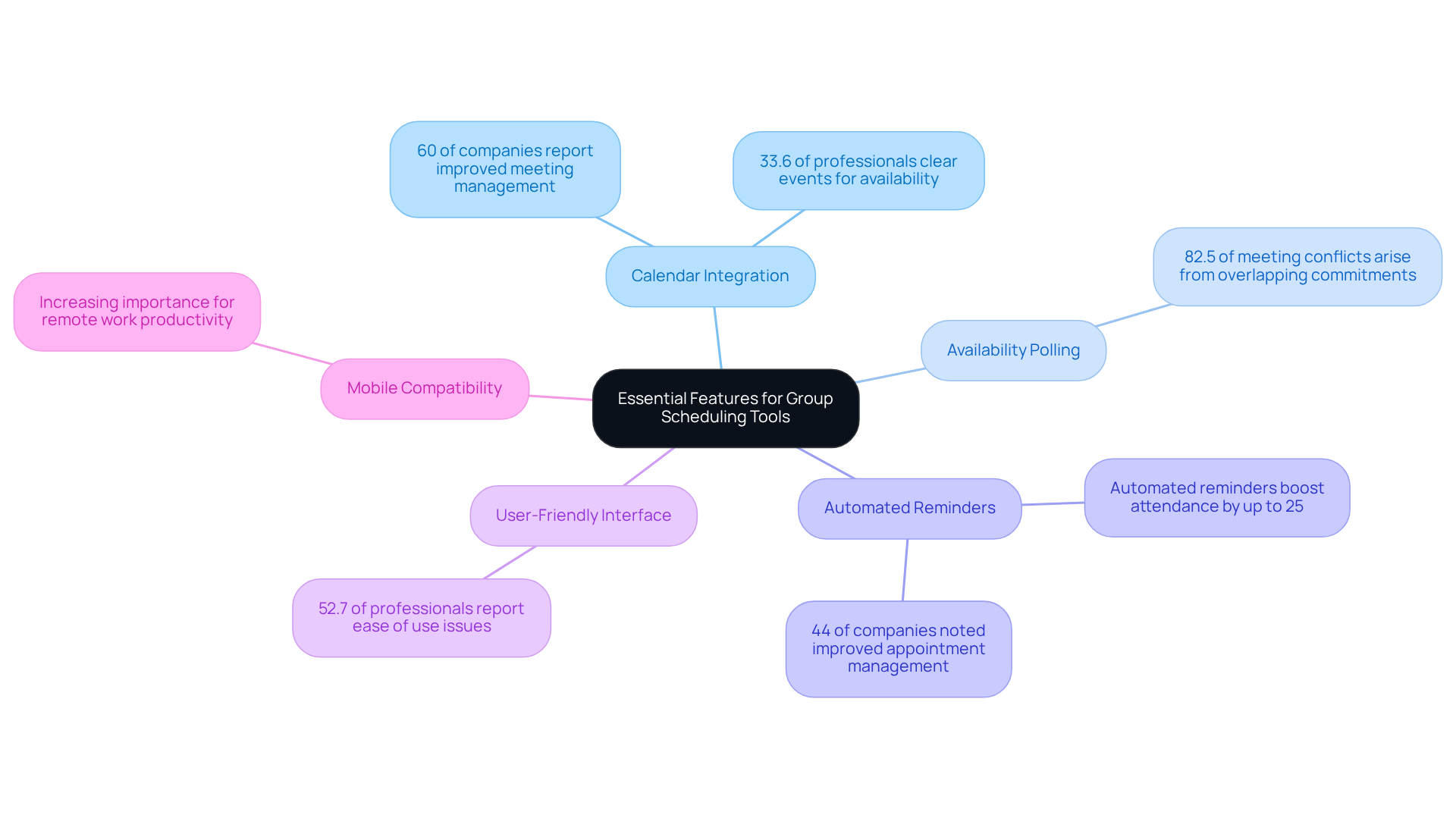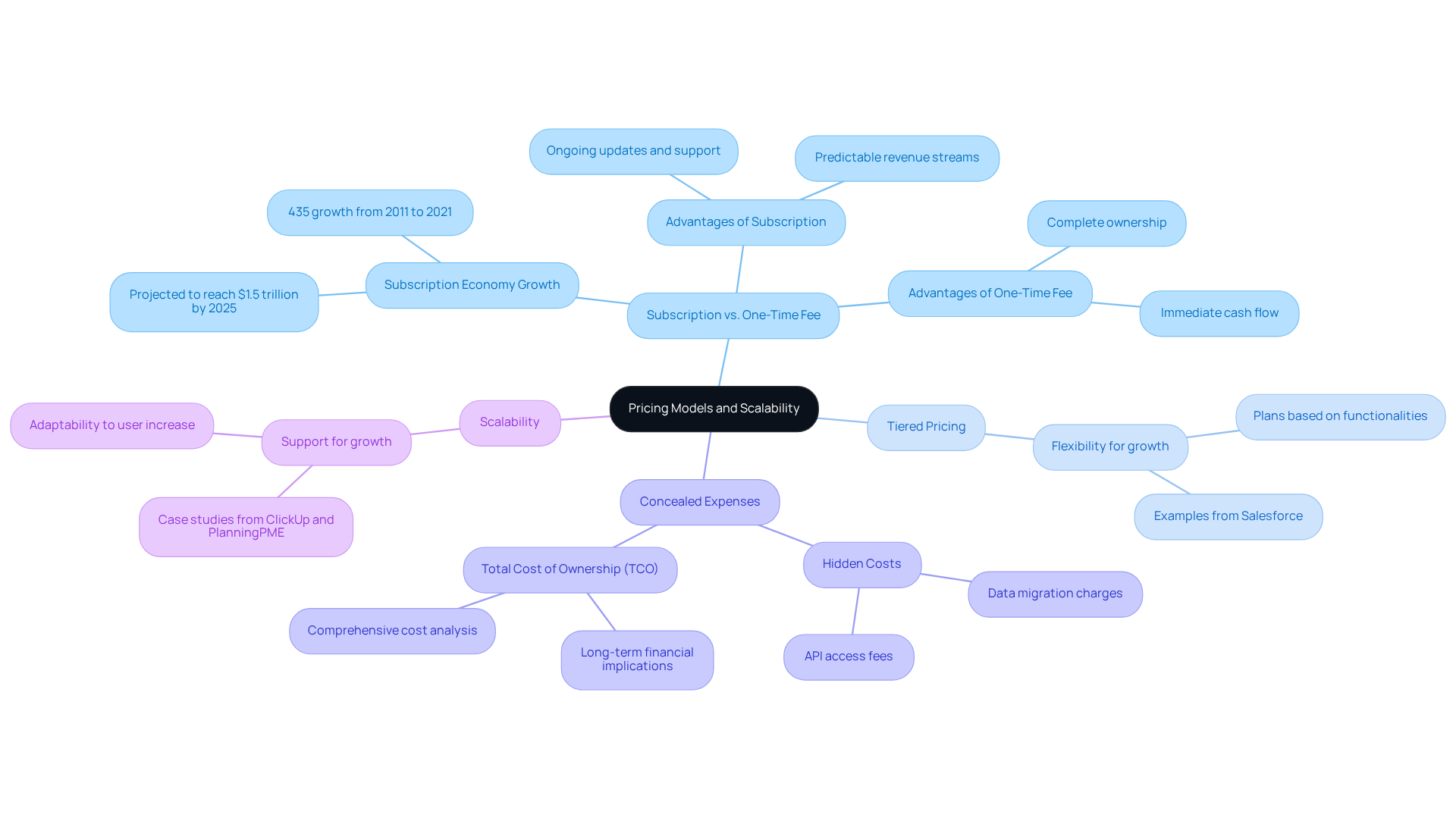Choose the Right Group Availability Tool: A Step-by-Step Guide

Introduction
Choosing the right group availability tool is crucial for enhancing productivity and collaboration within teams. The right tool can streamline operations, reduce scheduling conflicts, and foster better communication. However, with so many options available, organizations often face challenges in understanding essential features and evaluating user experiences. How can they effectively navigate the complexities of pricing models and integration options to select a tool that not only meets their current needs but also scales with future growth?
This guide provides a comprehensive, step-by-step approach to selecting the best scheduling software. It addresses common challenges organizations face and highlights key considerations for successful implementation. By following this guide, teams can ensure they make an informed choice that enhances their operational efficiency and communication solutions.
Identify Essential Features for Group Scheduling Tools
When selecting a group management application, it’s essential to focus on the group availability tool features that address your specific needs. Communication inefficiencies can hinder productivity, but the right tools can transform your approach. Consider these key features:
- Calendar Integration: Ensure the tool syncs seamlessly with popular calendars like Google Calendar and Outlook. This integration is vital, as 60% of companies report improved meeting management through planning software. Moreover, 33.6% of professionals remove events from their calendars to create more availability for booking links, underscoring the importance of efficient calendar management.
- Availability Polling: Look for resources that act as a group availability tool, allowing participants to easily indicate their availability. This feature addresses the common issue of meeting conflicts, with 82.5% of these problems arising from overlapping commitments.
- Automated Reminders: Tools that send reminders to participants can significantly reduce no-shows, with automated reminders boosting attendance by up to 25%. Additionally, 44% of companies noted improved appointment management automation after adopting planning software, highlighting the advantages of these resources.
- User-Friendly Interface: A straightforward, intuitive layout is crucial for allowing all users to navigate the application without extensive training. Ease of use is a frequent concern, with 52.7% of professionals reporting challenges with appointment links.
- Mobile Compatibility: Verify if the software offers a mobile application or is optimized for mobile use, facilitating on-the-go planning. With the rise of remote work, mobile access has become increasingly important for maintaining productivity.
As the Reclaim team aptly states, “Meetings are costly, unproductive, and inefficient. But they’re also collaborative, inspiring, and actionable for driving growth at your company.” By focusing on these essential features, you can streamline your selection process and choose tools that will genuinely enhance your time management efficiency.

Evaluate User Experience and Integration Options
When evaluating potential scheduling tools, it’s crucial to address the challenges of communication inefficiencies that can hinder productivity. A well-designed group availability tool can significantly streamline operations, making it easier for teams to collaborate effectively.
-
User Interface: First and foremost, assess the tool’s interface for intuitiveness. A user-friendly experience minimizes the learning curve, allowing your team to adapt quickly and efficiently.
-
Integration with Existing Resources: Next, ensure that the scheduling application seamlessly connects with other software your team relies on, such as project management systems or communication platforms. This integration is vital for maintaining workflow continuity and enhancing overall productivity.
-
Feedback from Users: Additionally, gather input from team members who will utilize the system. Understanding their preferences and pain points is essential for selecting a tool that meets their needs and fosters a positive user experience.
-
Trial Period: Finally, take advantage of free trials to evaluate how well the resource integrates into your workflow. This hands-on experience will help determine if the tool meets your expectations and enhances your team’s efficiency.
By concentrating on user experience and integration, you can confidently choose a group availability tool that boosts productivity rather than complicating processes.

Assess Pricing Models and Scalability for Future Growth
When evaluating pricing models for scheduling tools, it’s crucial to consider several key factors that can significantly impact your operational efficiency.
-
Subscription vs. One-Time Fee: First, assess whether the resource operates on a subscription model, which typically includes ongoing updates and support, or if it requires a one-time payment. Subscription models are gaining traction, with the subscription economy projected to reach a staggering $1.5 trillion by 2025. This shift reflects changing consumer preferences towards recurring revenue models. Notably, the subscription economy experienced a remarkable growth of 435% from 2011 to 2021, highlighting its rapid expansion and relevance in today’s market.
-
Tiered Pricing: Next, look for tools that offer tiered pricing models based on functionalities or participant counts. This flexibility allows you to select a plan that aligns with your current needs while providing options for future growth. For example, Salesforce has effectively implemented tiered pricing in its CRM offerings, enabling businesses to scale their usage as necessary. Tiered pricing is a common feature of subscription models, enhancing adaptability for various business sizes.
-
Concealed Expenses: Be vigilant about potential hidden costs, such as charges for additional functionalities, integrations, or overage penalties when exceeding limit thresholds. Examples of these hidden costs include API access fees and data migration charges. Conducting a thorough Total Cost of Ownership (TCO) analysis can help uncover these expenses, ensuring you grasp the full financial implications of your choice.
-
Scalability: Finally, confirm that the resource can support an increasing number of users or additional features as your organization grows. Case studies from ClickUp and PlanningPME illustrate how scalable solutions can adapt to evolving business needs, delivering excellent value while minimizing disruption. Subscription models often empower businesses to adjust software usage based on growth or changing requirements, underscoring the importance of scalability in your decision-making process.
By meticulously evaluating these pricing and scalability factors, you can select a planning solution that not only fits your budget but also supports your organization’s growth trajectory.

Test and Compare Tools to Find the Best Fit
To effectively evaluate and select the best scheduling tools, follow these essential steps:
- Create a Shortlist: Start by identifying tools that align with your core requirements. This initial selection should focus on elements crucial to your organization’s needs. As Sudipto Paul emphasizes, “The appropriate resource makes complex tasks more manageable and precise.”
- Conduct Trials: Take advantage of free trials or demo versions to explore each application’s functionalities and interface. Involve team members in this process to gather diverse perspectives and insights. A case study on selecting statistical analysis software underscores the significance of trials in navigating the selection process effectively.
- Contrast Attributes Next to Each Other: Develop a comparison chart detailing how each tool aligns with your key standards, including user experience, essential features, and pricing frameworks.
- Gather Feedback: After the trial period, collect comprehensive feedback from all participants. Understanding their experiences will reveal preferences and any challenges encountered during use. As one user noted, “With the right instrument, you can focus less on the technical side and more on making sense of the numbers to uncover the insights that matter.”
- Make an Informed Decision: Analyze the feedback and feature comparisons to select the resource that best enhances your scheduling efficiency and meets your organizational needs.
By systematically testing and comparing these tools, you can confidently identify the most suitable group availability tool for your organization.

Conclusion
Selecting the right group availability tool is not just important; it’s essential for overcoming communication inefficiencies that can hinder productivity. Organizations face significant challenges when scheduling meetings, often leading to conflicts and wasted time. By focusing on critical features – like calendar integration, availability polling, automated reminders, user-friendly interfaces, and mobile compatibility – teams can streamline their scheduling processes and enhance collaboration.
The right tool minimizes meeting conflicts and fosters a culture of efficiency, ultimately driving growth. Key insights throughout this discussion highlight the importance of evaluating user experience and integration options. A user-friendly interface, combined with seamless integration into existing resources, can transform operations. Moreover, assessing pricing models and scalability ensures that the chosen tool meets both current needs and future growth potential. Testing various options through trials and gathering feedback is crucial for making an informed decision that aligns with organizational requirements.
In conclusion, selecting an effective group availability tool can revolutionize how teams manage their time and collaborate. By prioritizing essential features and conducting thorough evaluations, organizations can enhance scheduling efficiency and cultivate a more productive work environment. Taking these steps today will pave the way for improved communication and collaboration tomorrow. Investing in the right scheduling software is not just a choice; it’s a pivotal decision that can shape the future of any organization.
Frequently Asked Questions
What should I consider when selecting a group scheduling tool?
Focus on features that address your specific needs, such as calendar integration, availability polling, automated reminders, user-friendly interface, and mobile compatibility.
Why is calendar integration important in scheduling tools?
Calendar integration is vital because it allows the tool to sync seamlessly with popular calendars like Google Calendar and Outlook, leading to improved meeting management. About 60% of companies report benefits from using planning software for this purpose.
What is availability polling and why is it useful?
Availability polling is a feature that allows participants to indicate their availability for meetings. It helps to resolve meeting conflicts, as 82.5% of these issues arise from overlapping commitments.
How do automated reminders impact meeting attendance?
Automated reminders can significantly reduce no-shows, boosting attendance by up to 25%. Additionally, 44% of companies have reported improved appointment management after using planning software.
Why is a user-friendly interface important in scheduling tools?
A straightforward, intuitive layout is crucial for allowing all users to navigate the application without extensive training. Ease of use is a common concern, with 52.7% of professionals facing challenges with appointment links.
What role does mobile compatibility play in group scheduling tools?
Mobile compatibility is important as it allows users to access scheduling tools on-the-go, facilitating planning and maintaining productivity, especially with the rise of remote work.
How can the right group scheduling tool enhance productivity?
The right tools can address communication inefficiencies and streamline the scheduling process, ultimately transforming your approach to time management and enhancing overall productivity.
